Because ball pythons have a reputation for being difficult to feed, many new keepers are anxious to begin feeding trials.
But don’t worry, I have good news:
The ball python’s reputation for being a poor feeder was certainly well-deserved a few decades ago. But, this isn’t an especially common problem anymore.
In the “old days,” most ball pythons for sale were wild-caught, stressed, and unhealthy. Understandably, they would often refuse food. Sometimes these fasts would last for months at a time.
I’ve struggled with dozens of food-averse ball pythons over the years, and I assure you the battle was incredibly frustrating. Enduring months of failed feeding attempts will take most of the fun out of snake keeping.
On the other hand, the vast majority of ball pythons sold today hatched in captivity. These snakes usually eat readily – many even become quite voracious.
But, before you start trying to feed your new pet, you’ll want to learn a bit about the kind of food your ball python needs and the best way to offer it.
We’ll discuss these things below, and we’ll even provide a few tips for tempting reluctant feeders.
> Further Reading: The Complete Ball Python Care Sheet
What Do Ball Pythons Eat in the Wild?
Wild ball pythons primarily subsist on rodents and birds in the wild. The exact species consumed appear to vary based on location and the abundant prey species in the area. The snake’s size and gender also influence the prey they eat. For example, males – who often climb more than females — appear to feed more heavily on birds in some places.
Ball Python Feeding Chart
Below, we’ve put together a handy chart for figuring out the right size food item for your ball python and the appropriate feeding schedule.
Again, it is always important to tailor the prey size offered and the feeding schedule implemented to your individual snake’s needs, but the information below should serve as a good starting point. Also note that some snakes will grow faster or slower than average – always choose food items based on your snake’s size, rather than his age.
| Snake Age | Snake Size | Prey Type | Feeding Schedule |
| Less than 4 months old | 70 to 200 grams | Mouse Hopper | Every 5 to 7 Days |
| 4 to 12 months old | 200 grams to 700 grams | Small Adult Mouse or Rat Fuzzy | Every 5 to 7 Days |
| 1 to 2 years old | 700 grams to 1,000 grams | Large Adult Mouse or Rat Hopper | Every 7 Days |
| 2 to 4 years old | 1,000 grams to 2,000 grams | Small Rat | Every 7 to 10 Days |
| More than 4 years old | More than 2,000 grams | Small or Medium Rat | Every 7 to 14 Days |
How Do You Feed a Pet Ball Python?
Although it can occasionally be difficult to entice a ball python to feed, the vast majority of captive-hatched individuals are eager eaters. Essentially, you’ll need to do the following:
1. Ensure that your snake is healthy and that his habitat is set up ideally.
Snakes – especially ball pythons – will often refuse food if they are not healthy and provided with an appropriate habitat. Most keepers who experience feeding difficulties will find one of these two factors to be the root of the problem.
Ideally, you’ll have taken your snake in for a veterinary examination shortly after purchasing him to ensure he is healthy. And, you can make sure you have the enclosure set up correctly by checking out our Ball Python Habitat Guide.
2. Obtain a frozen rodent of the appropriate size.
The best things to feed your ball python are frozen-thawed rodents (the rodents will be sold to you in frozen form, but you’ll want to let them warm up to room temperature before offering them to your snake). Feeding your pet frozen-thawed rodents eliminates the possibility that the rodent will injure your snake. It also ensures that the rodent won’t suffer.
Big adult mice or very small rats are usually the proper size for adults, but hatchlings will require smaller rodents. You can obtain frozen rodents at most pet stores that sell snakes. Or, you can purchase them online, directly from a rodent breeder.
3. Gently open the enclosure and present the rodent to your snake via a pair of long tongs or forceps.
It is important to avoid startling or stressing your snake before or during the feeding process. Do not handle him for at least a few hours before offering food and try to eliminate any unnecessary distractions. Kick excitable kids or pets out of the room and consider dimming the room lights a bit.
After opening the habitat, use the forceps to grab the rodent’s neck scruff – not the tail. Slowly move it in front of your snake and wait a moment to see if he strikes it. If he does not appear interested, you may need to “animate” the prey item, to make it appear alive.
4. Release the rodent once your snake strikes and constricts it.
With luck, your ball python will strike and constrict the prey item without hesitation. Once he does so, you’ll want to release your grip on the rodent and slowly back away from the habitat. If you want to walk away, you’ll need to close the enclosure very carefully to avoid spooking the snake. If you want to watch your snake eat, just leave the enclosure open until he swallows the food item.
5. Wash your hands, clean up any mess and leave your snake alone.
Always practice good hygiene when feeding your snake. Wash your hands afterward (I always wear latex gloves during feeding just to make things easier), as well as the forceps.
Also, it is important to note that rodents will occasionally leak blood, urine or feces during the feeding process. You’ll want to clean up any such messes promptly, but try to avoid bothering your snake in the process. Handling your snake after a meal can lead to regurgitation, so leave your snake to rest quietly for at least 24 to 48 hours after each meal.
> Further Reading: The Ball Python Behavior & Health
Ball Python Feeding FAQ
Below, we’ll try to address some of the common questions ball python keepers often have.
How often do ball pythons eat?
Wild ball pythons don’t have a set feeding schedule – they can only eat when they either find prey or a prey animal walks by them. However, they probably eat about once every week or two in the wild.
Different keepers employ different feeding regimens for their captive. Most feed their pet once every week, but others feed their snake twice per week, and still, others feed their snakes once every third week. Just be sure to monitor your snake’s weight to ensure you are providing an appropriate amount of food.
How long can a ball python go without eating?
Ball pythons are famous for engaging in fasts that last for several months at a time. This probably stems from the tendency for wild ball pythons to fast during the dry season, when food becomes scarce. Additionally, males of many snake species often cease feeding during the breeding season.
Do not panic if your snake begins to refuse food. As long as he is healthy, he should be able to go several months without eating before suffering any harm. Many captives have refused food for more than a year before finally starting to eat again.
> Further Reading: How Long Can a Ball Python Go Without Eating?
Is My Ball Python Underweight?
Examining its body shape is one of the most reliable ways to tell if your ball python is underweight. A healthy ball python should have a well-defined backbone and obvious musculature on the sides of its body when viewed from above.
f the snake appears thin, and its backbone is visible, or if the body appears sunken and the skin seems to hang loosely on the body, then your ball python is likely underweight.
For more detailed information about recognizing underweight ball pythons, please see our article on underweight ball pythons.
What do ball pythons eat besides mice?
Ball pythons in the wild eat a wide variety of rodents aside from mice, and they also eat small birds. In captivity, you can try to feed them any appropriately sized, commercially bred rodent. This includes domestic mice or rats, multimammate mice, gerbils, and hamsters. You can also feed them very small chicks or ducklings.
What do baby ball pythons eat?
Young ball pythons may consume the occasional lizard in the wild, but most eat rodents. They do, however, require smaller rodents than adult ball pythons do. “Hopper” mice are usually ideal for hatchlings, and it doesn’t take very long for hatchling ball pythons to grow large enough to handle small adult mice.
Why Is My Ball Python Not Eating?
For a variety of reasons, ball pythons occasionally present feeding challenges for their keeper. Specifically, they may refuse food for extremely long periods of time.
I don’t mean they will skip the occasional meal – all snake species do so from time to time. But ball pythons will occasionally refuse to eat for weeks, months, or even years in exceptional cases. These types of long fasts can not only be detrimental for your pet’s health, but they can also cause considerable frustration and anxiety for the keeper.
We discuss this issue in-depth in our article about ball pythons who won’t eat, but we’ll explain the basic reasons ball pythons fail to feed and what you can do about it below.
Reasons that Ball Pythons Refuse Food
There are a few reasons ball pythons will refuse food, including some that are common to most snake species as well as a few reasons that are unique to ball pythons. The most common causes of food refusal include:
- Your snake is in poor health
- Your snake is battling internal parasites
- Your enclosure is not properly set up
- Some snakes fast during the winter months
- Ball pythons may prefer specific prey
Tempting Your Ball Python to Eat
Now that you understand some of the reasons that ball pythons may refuse food, we can move on to a few helpful tips and tricks, which may help you get your snake to eat. A few of the best strategies for tempting finicky ball pythons include:
- Review all of your husbandry procedures and the habitat set up
- Take your snake to the vet
- Try to feed your snake at night
- Experiment with different types of prey
> Further Reading: How Long Can Ball Pythons Go Without Eating?
How Do Ball Python Drink Water?
Ball pythons drink water is much the same way that most other snakes do. They’ll usually lower the tip of their mouth to the water dish and then draw water into their mouths by moving their lower jaw. Some snakes actually put most of their face in the water while doing so, but this is no cause for concern.
Additionally, ball pythons may drink water droplets from their bodies or the environment. However, they aren’t as likely to do this as some other snakes, such as many tree-dwelling snakes, are.
Many ball pythons hail from relatively dry regions, so they don’t have the water requirements that many rainforest-dwelling snakes do. Many may only drink once or twice per week. However, it is important to ensure your ball python has access to clean, fresh water at all times.
Bon Appétit!
Hopefully, we’ve helped you understand the basic procedure for feeding a ball python, and you feel confident enough to start offering your pet food. Just remember to start by ensuring your snake is healthy and enjoying an ideal habitat, and you’ll likely find that your snake eats readily. And we’ve also explained a few ways that’ll usually tempt finicky individuals.
Tell us all about your ball-python feeding experiences in the comments below, and be sure to share this article with your friends if you’ve found it helpful.

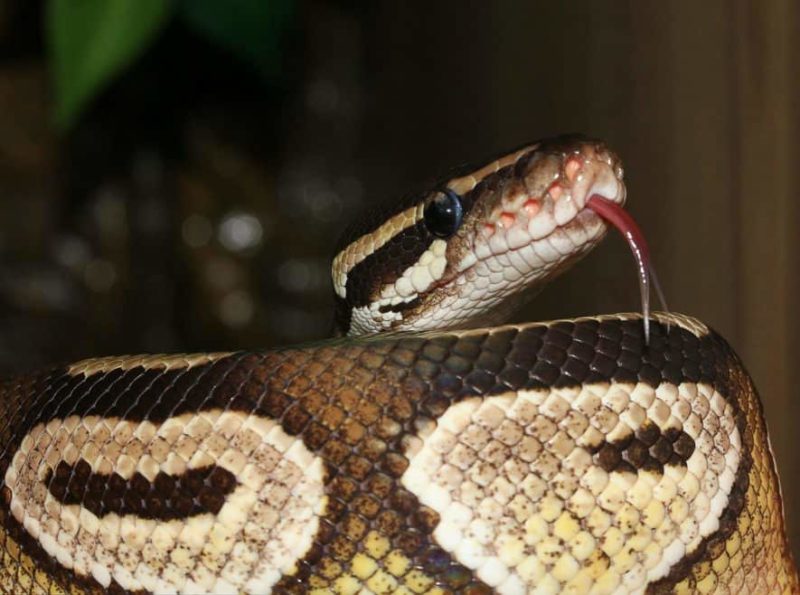







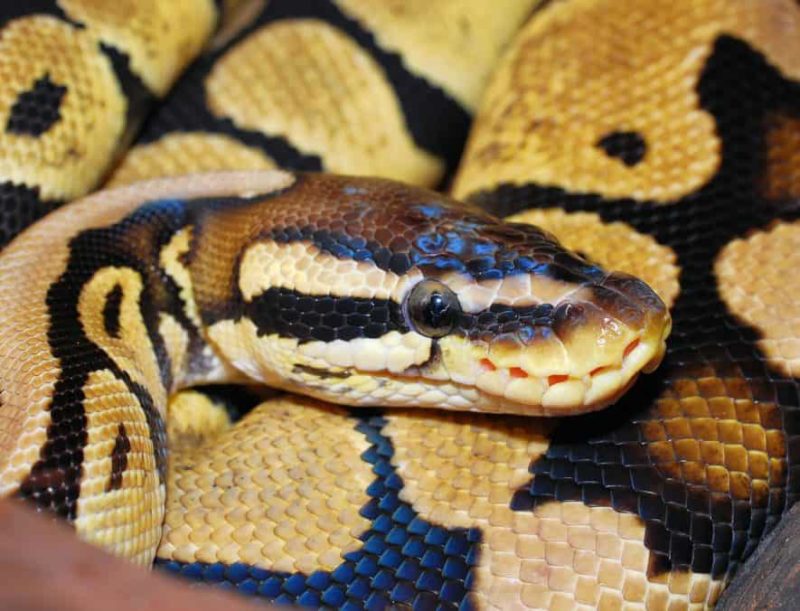
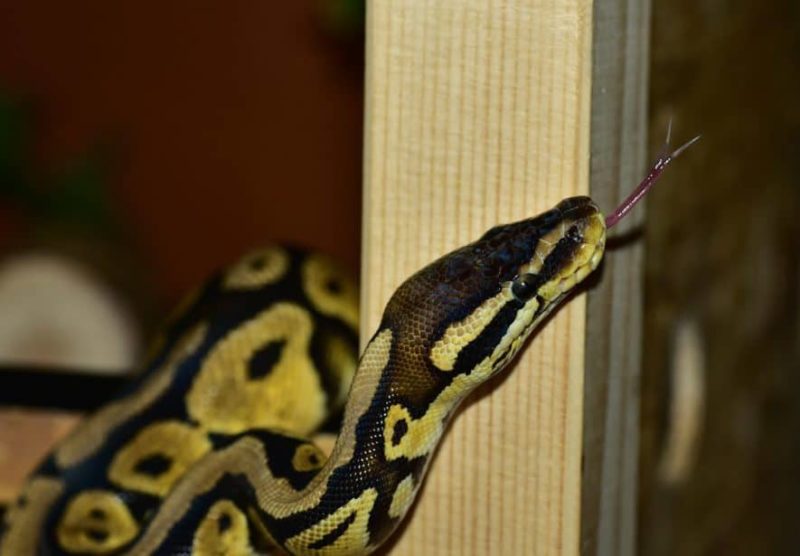
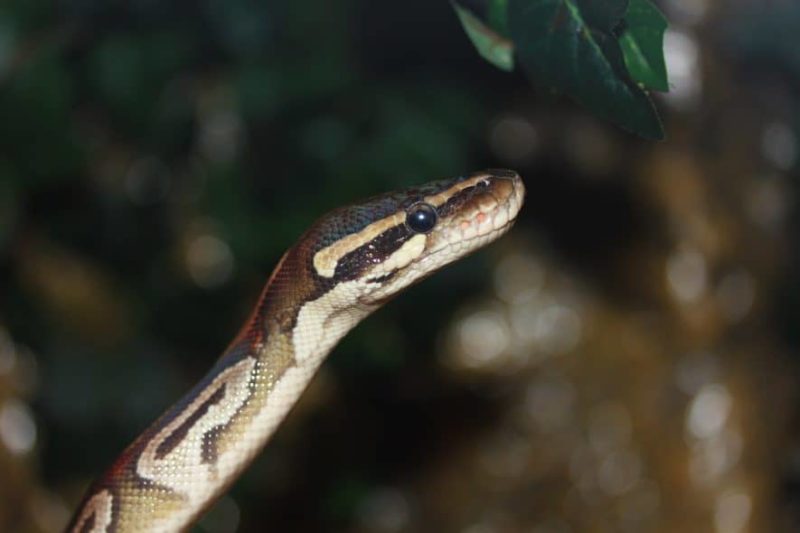
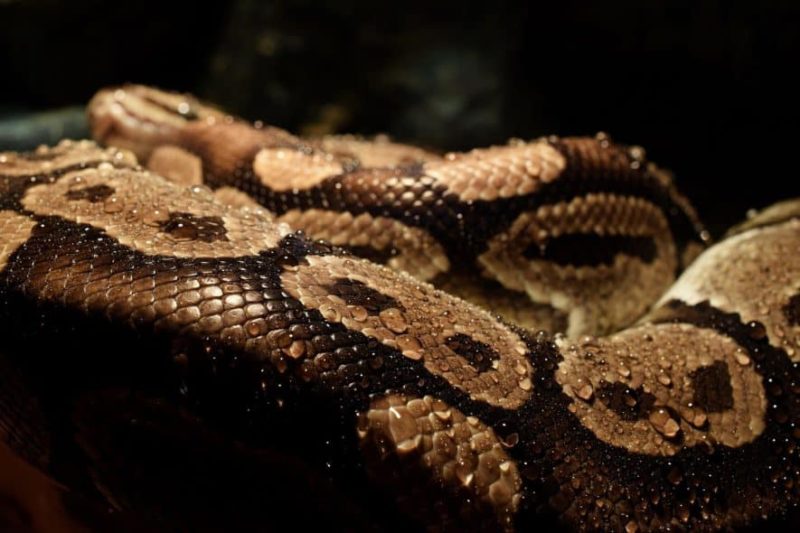
21 Comments
I have a 5yr old BP, and I prefer to feed him in a separate feeding container, rather than in the enclosure, which means I handle him briefly to take him to the feeding area. After feeding, I let him sit on my lap for 30mins before returning him to the enclosure. He is used to this weekly routine and is very expectant for his meal when he is placed in the feeding container.
The article mentions not to handle for a few hours before feeding, and not to handle after feeding. Should I wait and let him stay in the feeding container a few hours before feeding? I usually wait until 15-20mins after the rodent is consumed before taking him out of the container.
Hi Daphne!
It’s great that you have a routine for feeding your 5-year-old ball python. Handling your snake briefly to move them to a separate feeding container is a common practice to prevent any substrate ingestion during feeding.
Regarding handling before and after feeding, it’s generally recommended to minimize handling for a few hours before feeding to allow your ball python to settle and prepare for their meal. Similarly, it’s advised to avoid handling for a few hours after feeding to give them time to digest their meal without any disruptions.
In your case, if your ball python is comfortable and expectant in the feeding container, you can consider waiting for a few hours before feeding to allow them to adjust to the feeding environment and reduce the need for immediate handling. Waiting until 15-20 minutes after the rodent is consumed before taking him out of the container is a reasonable approach.
Remember, every snake is unique, and individual preferences may vary. Keep observing your snake’s behavior and adjust your routine as needed to ensure their well-being and comfort. If you have any more questions or concerns, feel free to ask!
If for some reason my ball python decided he doesn’t want his thawed meal, can I refreeze and try again the next day/night?
Hi Sarah, I wouldn’t recommend refreezing a thawed prey item. The freezing, thawing, refreezing, and rethawing process breaks down tissue making the skin thin. There is always that possibility that next time you thaw, when the snake goes to constrict that the belly could explode. It’s best to dispose of any uneaten thawed prey and offer a fresh one next time.
I have a bald python about 7 months old was eating ok and no he’s just not interested. He looks OK his habitat is set up he’s always coming out just to mooch about before his light just goes off. He strikes once sometimes but then appears like he’s not interested. I’m not sure what I’m doing wrong if anything.
Hi Deb,
I understand that you are having some trouble with your pet python. It sounds like the habitat is set up correctly, but he may be feeling stressed out or even bored. I have had a similar issue before with my Python and was able to resolve it by providing more enrichment activities in his enclosure.
Try adding branches for him to climb on or different-sized rocks for him to hide. Additionally, you can also try providing different types of food like frozen mice or crickets as well as live food. By doing this, it should help engage your pet python and make him more interested in eating again.
I hope this helps! Good luck!
Thanks for pointing out that pythons can drink water from a dish. I’m thinking about looking for ball pythons for sale because I’ve always wanted to have one as a pet. Preparing a dedicated place for it at home will make feeding it a lot simpler to do.
Hey so I’m looking at getting a ball python and I was wondering if they can go back and forth between two houses every week. My parents are divorced so I wanted to take it back and forth if the cages are identical but based on what I’ve been reading they get stressed easily. I am able to leave it at one house if necessary. I also wanted to know if I can hold it for 5-10 minutes more than once a day or if I can only hold it that long once a day and if I can hold it more than once a day how long should I leave it after holding it (I’m referring to it as an it since I don’t have it yet). I really appreciate it. 🙂
Hey, Tasha.
Your snake may adapt to a back-and-forth lifestyle, but I certainly wouldn’t recommend it. I’d definitely encourage you to pick one home and just let him live there.
As for handling him, it really depends on the snake. The 5 to 10 minute guideline is just that – a guideline. I’ve had snakes that would get stressed by being handled at all, and I’ve had others that would tolerate hours of handling several times a week (they were animals used for teaching programs). You just have to see how your snake adapts and go from there. If he continues to remain healthy and feed regularly, you can gradually increase the amount of time you spend handling him. Just be sure to keep your pet’s well-being in mind and do everything you can to give him the best quality of life possible.
Best of luck!
I have a ball python (not sure if a male or female, or the age? How can I tell how old she is and sex?) She” is about 24 inches long and her girth is about 2.5 inches. We have had her since January. She is healthy, sheds great, colorful, etc..
She was a great eater of frozen thawed large mice. I felt she needed to be eating a weaned rat, she wouldn’t touch it! I started feeding her 2 days a week back to back large mice. She will eat that every time! Everyone in the pet store in the snake department are telling to keep trying to feed her weaned rats. I have tried everything. Getting a larger feeding tank, soaking the rat (she likes wet mice.) with mice, rubbing mice bedding on the dry rat offering the dry rat, I even exposed the rats brains today! 🤮 she just doesn’t want it! Someone told me I may have to switch to live! I don’t want to do that! Also said mice are like dessert and they are very high in rat? She hasn’t eaten in 3 weeks. I can see her spine a little bit. She’s still active and colorful though.
Do I say to hell with offering rats and feed her the large frozen mice (do they make x large mice?) ? Back to back?
Any help will be greatly appreciated!
Hi, Brittany.
There is no way to determine your snake’s age, unless you know his or her birthday. As for your pet’s sex, I’d recommend taking her to your vet; he or she can perform a procedure known as probing to determine whether your pet is a male or female. You may also be able to get a friend who has experience performing the procedure do it for you.
As for your pet’s rat aversion, that’s actually a common problem among some snakes (jungle carpet pythons, for example, are often very difficult to switch to rats). It usually isn’t common among ball pythons, but all snakes are individuals, with varying preferences.
It does sound like you’ve tried all of the common tricks (and kudos for that!), so I’d just stick with mice. Just be sure that you’re providing enough food. Keep an eye on your pet’s body weight and body condition – you definitely don’t want the spine to be visually obvious. I’d recommend feeding two or three mice per feeding for a week or two to help put some weight back on him/her.
Best of luck!
My female3 month old python is very hissy at strangers and when i have her in my hand she rubs her head up against me . Like a cat would . Strange behavior . She don’tstress when i hold her . She hangs on pretty tight. I love Sugar .
Sounds like a great snake, Iris! Just be sure you don’t handle her too often and make sure that you are careful when letting others touch her if she’s nervous.
Thanks for sharing!
Hello. I’m very concerned for my snake. He’s not being fed enough and I don’t know what to do. I’m only fourteen so I can’t go and get him mice myself (he only eats live) and my dad gets mad at me when I show concern. I got him from my Uncle. He’s 22(? I think? Could be older) and he’s only getting fed about once every six or so weeks. My dad says that it’s normal and he’s lived like that for years. My snake is pretty underweight (his spine sticks out slightly) and I’m just very concerned.
Hey there, buddy. An obviously visible spine is not a good sign, and it does sound like your pet is underweight. A once-per-six-week feeding schedule may work for many snakes (especially adult males), but the meals would likely need to be relatively large. If your corn snake is an adult, you probably want to switch to small rats if you only want to feed him once every six weeks.
Just as importantly, I would strongly encourage you to convert him to pre-killed prey. This is especially important if you plan to switch to rats, as they can inflict very serious wounds on snakes. Additionally, you could then buy them in bulk and store them in the freezer, which means you won’t have to get your dad to drive you to the pet store very often.
Best of luck! Let us know how it goes.
i have a female ball python she normaly gose off feed once a month but as of lately she hasn’t soon any interest in food and has lost almost 150g in a moth what should i do
It’s always a good idea to visit the vet anytime your snake begins doing anything unusual – and I’d say that prolonged food refusal certainly qualifies (particularly if your snake normally eats well).
Your snake may be perfectly fine and just refusing food for her own reasons – that’s certainly not unusual for ball pythons. But, it could also signal the presence of parasites or some other health problem, so it’s better to be safe than sorry.
Let us know what your vet has to say!
Hi, I have a female Ball Python and she is probably atleast 6 years old. Recently she has been having issues eating. Not actually consuming the food but seeing the rat. It’s like she can’t see them anymore. She will get super close to it and the rat will scare her away or she will look above the rat. Sometimes she will just stare at the glass of the tank when the rats in there. Almost, like she can’t see.. Have you heard of anything like this before? Thanks in advance for your time.
Hi I Kno this was in the past but I also have a pinstripe bp that does this exact thing she’s young to so I don’t think it do to bad vision she just get super close and spooks just like above …I use to take the prey out after a hr or so now I leave in over night and I have had way better successful feedings ..hope this helps ..rp
I have a question bout my bald python…. I gave him a large rat, hes bout 2 years old. He got it half way down to the middle of his body then the next day he must have thrown it up. Is this normal.
Hi Melinda. A snake regurgitating his meal is not something normal. You can refer to our feeding chart in this article to see if the size of the rat was appropriate. There are 2 main reasons that would explain why your snake regurgitated his meal :
– an inappropriate temperature at night in his terrarium (we recommend at least 68 to 70°F) – you can find more details about it in our ball python habitat guide,
– the fact you handled him before he could complete the digestion process (you should wait for at least 24 hours and preferably 48 hours) – you can find more details about it in our ball python health and behavior article.
If you believe it isn’t one of these reasons, you should bring your pet to see the vet. Bring the regurgitated food with you as it might help the vet to understand what happened. Hope this will be helpful for you and your ball python!